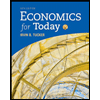The Coase theorem states that if transactions costs are low, property rights are assigned, and parties understand how much they value something, private bargaining will result in an efficient solution to the problem of externalities. government intervention is always needed if externalities are present. a free market equilibrium is the best solution to address externalities. assigning property rights is the only thing the government should do in a market economy.
The Coase theorem states that if transactions costs are low, property rights are assigned, and parties understand how much they value something, private bargaining will result in an efficient solution to the problem of externalities. government intervention is always needed if externalities are present. a free market equilibrium is the best solution to address externalities. assigning property rights is the only thing the government should do in a market economy.
Microeconomics A Contemporary Intro
10th Edition
ISBN:9781285635101
Author:MCEACHERN
Publisher:MCEACHERN
Chapter17: Externalities And The Environment
Section: Chapter Questions
Problem 6QFR
Related questions
Question
The Coase theorem states that
|
if transactions costs are low, property rights are assigned, and parties understand how much they value something, private bargaining will result in an efficient solution to the problem of externalities.
|
||
|
government intervention is always needed if externalities are present.
|
||
|
a free
|
||
|
assigning property rights is the only thing the government should do in a market economy.
|
Expert Solution
Step 1
Coase theorem states that the ideal condition is that the involved party have the bargaining right which would reflect the full cost and as per the value of the property right, it would result in the most efficient outcome in the market.
Trending now
This is a popular solution!
Step by step
Solved in 3 steps

Knowledge Booster
Learn more about
Need a deep-dive on the concept behind this application? Look no further. Learn more about this topic, economics and related others by exploring similar questions and additional content below.Recommended textbooks for you


Essentials of Economics (MindTap Course List)
Economics
ISBN:
9781337091992
Author:
N. Gregory Mankiw
Publisher:
Cengage Learning

Principles of Microeconomics (MindTap Course List)
Economics
ISBN:
9781305971493
Author:
N. Gregory Mankiw
Publisher:
Cengage Learning


Essentials of Economics (MindTap Course List)
Economics
ISBN:
9781337091992
Author:
N. Gregory Mankiw
Publisher:
Cengage Learning

Principles of Microeconomics (MindTap Course List)
Economics
ISBN:
9781305971493
Author:
N. Gregory Mankiw
Publisher:
Cengage Learning



Economics (MindTap Course List)
Economics
ISBN:
9781337617383
Author:
Roger A. Arnold
Publisher:
Cengage Learning